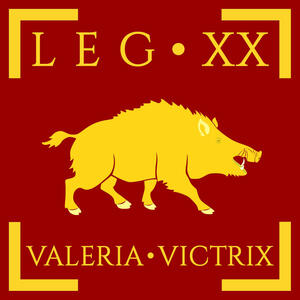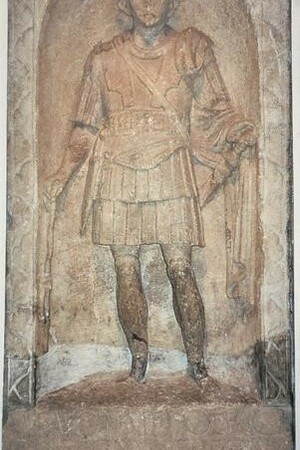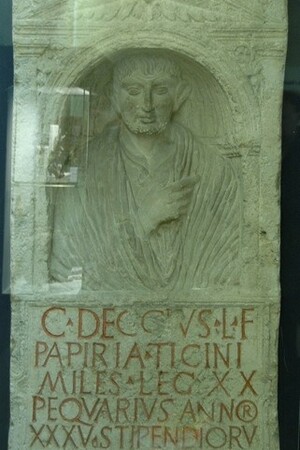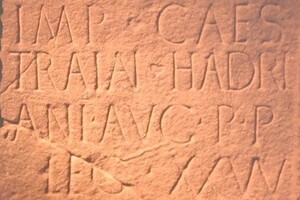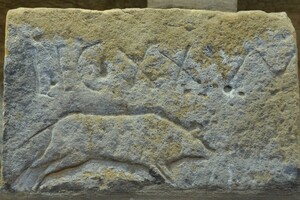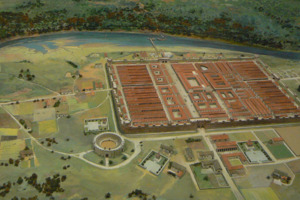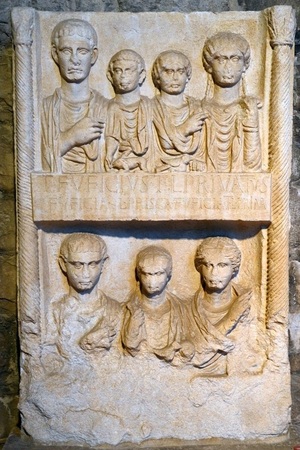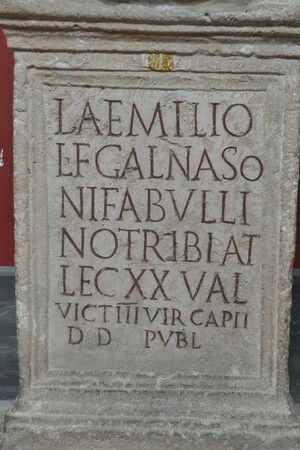Roman Legion - Legio XX Valeria Victrix
Title: Legio XX Valeria Victrix (Twentieth Victorious Valeria Legion) - a Roman legion formed by the order of Octavian Augustus after the Battle of Actium in 31 BC.
Dates of existence: 31 BC – 296 AD.
Logo: boar (wild boar), in the 1st century AD a Capricorn was also used, but in the 2nd and 3rd centuries its depiction was abandoned.
Nickname: Valeria Victrix (Valiant and Victorious). In the 3rd century AD, the full name of the legion was: Legio XX Valeria Victrix Antoniniana Deciana.
Battle Path
- Legio XX Valeria Victrix was formed by order of Octavian Augustus after the Battle of Actium in 31 BC from the legionnaires of Octavian Augustus and Mark Antony.
- The cognomen of the legion has three possible origins: Direct translation from Latin Valeria Victrix "Valiant and Victorious." In Latin, the word "Valeria" denotes a black eagle depicted on legion standards. In this case, "Valeria Victrix" means "Victorious Black Eagle." The Latin word "Valeria" can also be interpreted as "black." In this case, it may be a translation into Latin of the Sabine cognomen of Emperor Tiberius.
- The time of assigning such a cognomen to Legio XX Valeria Victrix also varies. According to versions #1 and #3, this title was awarded in 6 AD after the Marcomannic War. According to version #2, Legio XX Valeria received this name in 61 AD after suppressing the Boudica uprising in Britain.
- The baptism of fire for Legio XX Valeria Victrix was its participation in the Cantabrian Wars in Spain (Latin: Hispania Tarraconensis) during the reign of Emperor Octavian Augustus from 25-13 BC.
- Veterans of legio XX Valeria Victrix were settled in the newly established city of Augusta Emerita (modern-day Mérida, Spain).
- In 20 BC, a vexillation of legio XX Valeria Victrix was transferred to Burnum (a Roman military base and town in Dalmatia, now territory of Croatia and Montenegro) in the Balkans, while the main forces of the legion were stationed in Aquileia (a Roman city in northern Italy, now ruins east of modern-day Venice, Italy).
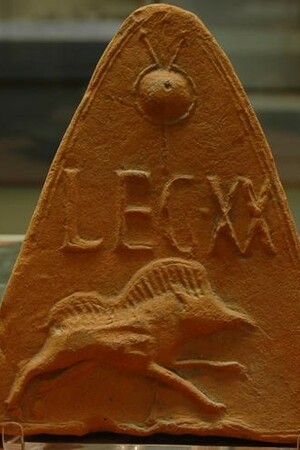 Antefix with a boar, the symbol of Legio XX Valeria Victrix. London, British Museum. 1st century AD.
Antefix with a boar, the symbol of Legio XX Valeria Victrix. London, British Museum. 1st century AD.
- In 6 AD, legio XX Valeria Victrix took part in the campaign against the Marcomanni as part of Tiberius's army. It is likely that in this campaign, legio XX Valeria Victrix distinguished itself and earned its title. One of the distinctions of legio XX Valeria Victrix in this campaign is mentioned by the Roman historian Velleius Paterculus, author of "Roman History."
- In 9 AD, after the Roman defeat in the Teutoburg Forest, legio XX Valeria Victrix briefly stationed at Ara Ubiorum (modern-day Cologne, Germany), later moving to Novaesium (modern-day Neuss, Germany).
- Legionnaires of legio XX Valeria Victrix were involved in three campaigns of Germanicus in "free" Germany.
- In 21 AD, under Emperor Tiberius (reigned 14-37 AD), legio XX Valeria Victrix took part in suppressing the revolt of the Turoni tribe in Gaul, who rebelled due to high Roman taxes.
- Under Emperor Caligula (reigned 37-41 AD), Legio XX Valeria Victrix participated in his German campaign.
- Under Emperor Claudius, Legio XX Valeria Victrix took part in the Roman conquest of Britain in 43 AD. The first camp in Britain for Legio XX Valeria Victrix was Camulodunum (modern-day Colchester), the capital of the Trinovantes, along with other Roman army units.
- Then in 48 AD, Legio XX Valeria Victrix was moved to Kingsholm in Gloucester, and in 57 AD transferred to Usk.
- In 61 AD, together with Legio XIIII Gemina under the command of Gaius Suetonius Paulinus, legio XX Valeria Victrix participated in suppressing Boudica's revolt, where it possibly distinguished itself and earned its cognomen.
- After suppressing the revolt, legio XX Valeria Victrix was transferred to Deva (modern-day Chester, England).
- In the "Year of the Four Emperors" (69 AD), Legio XX Valeria Victrix supported Vitellius, even sending a large vexillation to Rome. After Vitellius's defeat, Vespasian returned this detachment to Britain.
- In 75 AD, Legio XX Valeria Victrix was transferred to Viroconium, from where the governor of Britain, Gnaeus Julius Agricola, previously the legate of Legio XX Valeria Victrix, led the troops north against the Brigantes tribe in 78 AD. This campaign was successful, and northern England became part of the Roman Empire.
- Additionally, Agricola used Legio XX Valeria Victrix in his campaign in Scotland from 78 to 84 AD.
- A vexillation of Legio XX Valeria Victrix also participated in Emperor Domitian's campaign against the Chatti tribe in 83 AD. From 122-125 AD, legionnaires of Legio XX Valeria Victrix participated in building Emperor Hadrian's Wall and Antonine Wall (around 140 AD), constructed during Emperor Antoninus Pius's reign in Britain.
- From 155-158 AD, legionnaires of Legio XX Valeria Victrix took part in suppressing a major anti-Roman uprising in Britain. Local legions were reinforced with support from legions in Germany.
- In 196 AD, the governor of Britain, Clodius Albinus, attempted to become emperor and rebelled against the legitimate Emperor Septimius Severus. Albinus was supported by the British legions, including Legio XX Valeria Victrix.
- Albinus transferred his legions to the continent, but in the spring of 197 AD, his forces were defeated by those of Emperor Septimius Severus. During the struggle for power in the empire, northern tribes seized Roman Britain, and the returning Roman forces, including Legio XX Valeria Victrix, had to reclaim Britain for Rome. The war was lengthy. Emperor Septimius Severus arrived in Britain in 208 AD.
- Legio XX Valeria Victrix fought in northern Britain along the west coast and returned to camp in Chester during the reign of Severus's son, Emperor Caracalla (reigned 211-217 AD). At this time, legio XX Valeria Victrix received the title Antoniniana (Antonine).
- Between 249 and 251 AD, Legio XX Valeria Victrix had the title Deciana ("Legion of Decius"), in honor of Emperor Decius Trajan (reigned 249-251 AD), but it is unknown what earned the legion this title.
- In 255 AD, a vexillation of legio XX Valeria Victrix fought in Germany, and after the victory, this vexillation was sent to the Danube.
- In 286 AD, Legio XX Valeria Victrix came under the control of the usurper Carausius (Roman emperor-usurper of Britain and Northern Gaul, reigned 286-293 AD), and then Allectus (Roman usurper - emperor, who overthrew Carausius and ruled Britain and Northern Gaul from 293-296 AD).
- Presumably in 296 AD, when Constantius I Chlorus (reigned 293-306 AD) defeated Allectus, reclaiming Britain under Roman control, Legio XX Valeria Victrix was disbanded as punishment for supporting the usurpers.
- No information about Legio XX Valeria Victrix in the 4th century is found.
Related topics
List of Roman Legions, Legion, Legionnaire, Legio XIX, Legio XIIII Gemina, Octavian Augustus
Literature
1. M. Hassall, "Pre-Hadrianic disposition of legionaries in Britain," in: Richard J. Brewer (ed.), "Roman Fortresses and Their Legions." Papers inHonor of George Boon (2000)
2. M. Hassall, "Fortresses of the Legionaries in Britain," in: Yann Le Bohec, Les légions de Rome sous le Haut-Empire (2000, Lyon) 441-457.
3. L. Keppie, "The British Legions. Legio II Augusta, VI Victrix, IX Hispana, XX Valeria Victrix," in: Yann Le Bohec, Les légions de Rome sous le Haut-Empire (2000 Lyon) 25-37.
4. S. Perea Yebenes, "Hispania y la legio XX," in: Yann Le Bohec, Les légions de Rome sous le Haut-Empire (2000 Lyon) 581-587.
5. R. Cagnat. A Brief History of Roman Legions.
